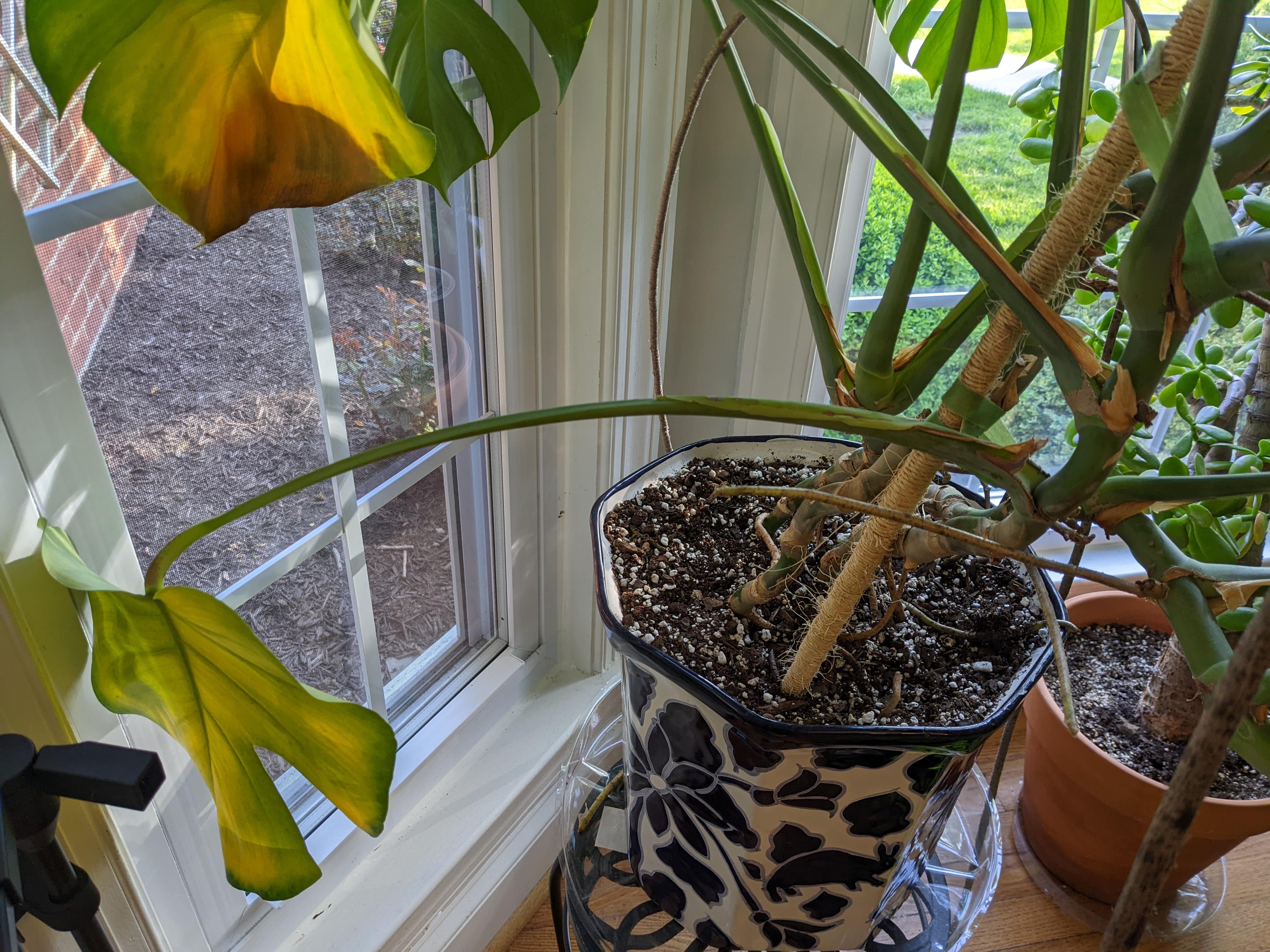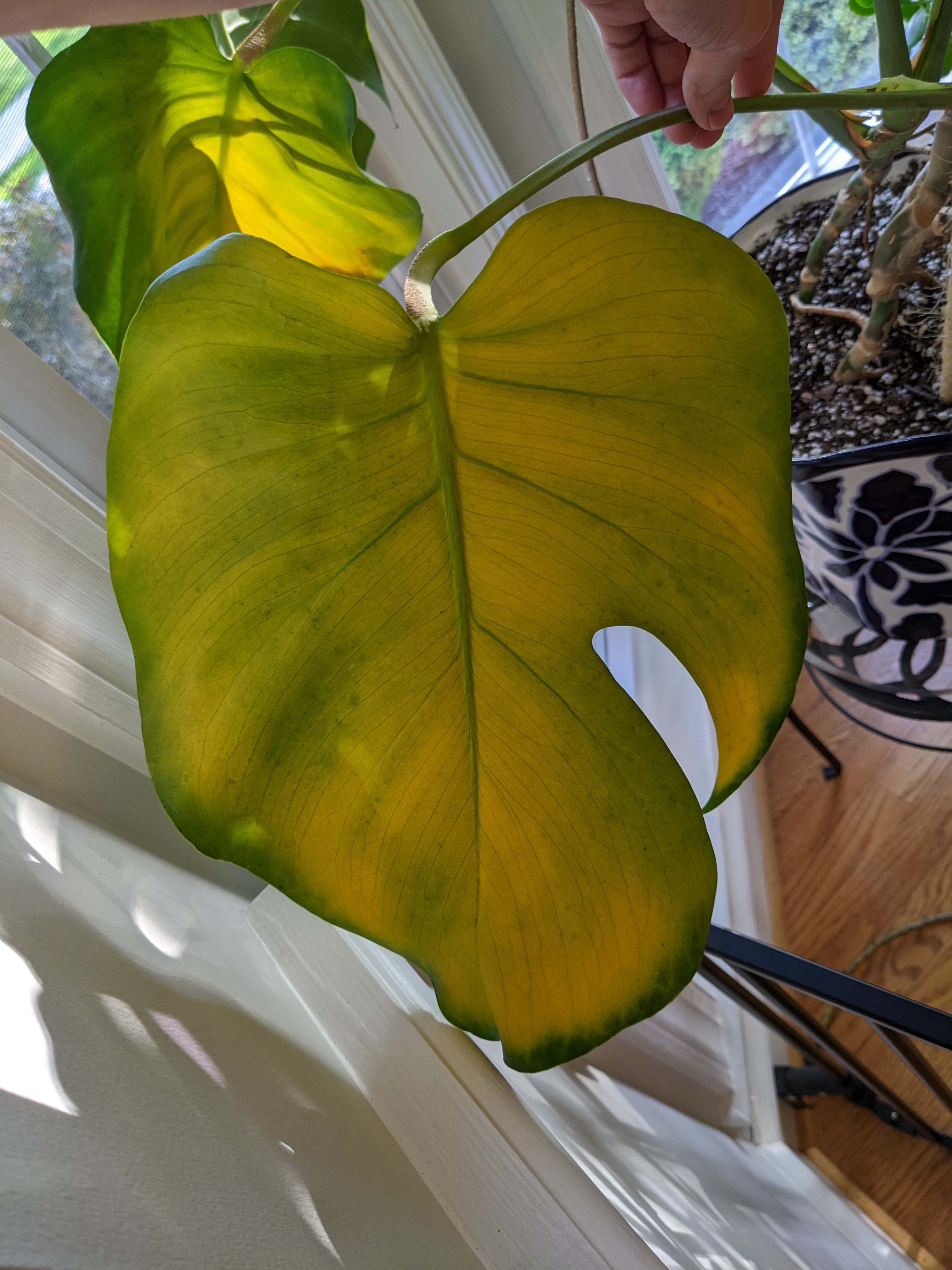What Turns Monstera Leaves Yellow?
My old Monstera had a few yellow leaves recently, which made me think it would be nice to write a post about this might happen. I follow many plant subreddits and I can't tell you how many posts I see of people worried about yellow leaves. That's great though, right? Your plant is trying to tell you something and you want to listen. In this post, I'll cover what turns Monstera leaves yellow.
Reasons Your Monstera Leaves Yellow
Water Issues
Both over and underwatering can cause your Monstera to have yellow leaves. My favorite method to tell if there are water issues is to use a soil moisture meter. Something simple like this soil moisture meter does the trick for me, and I've been using one like this for many years. Your finger works too. You want to make sure the top inch or two of the soil feels dry before you water your plant.

I'm a bit of a chronic underwaterer. In my opinion, it's just easier to deal with an underwater plant rather than an overwatered one. When my Monstera is underwater it's pretty easy to spot because the leaves of the whole plant seem a little droopy. If you are underwatering typically the leaves that turn yellow first are the oldest ones at the base of a stem. These are the older leaves and tend to be more susceptible to drying out. You can see some examples in the photo above. The two leaves that are yellowing are the lowest on the vine.
If your soil feels moist and the yellow leaves are not concentrated at the base of the stems, but more evenly disbursed, then you may be dealing with overwatering. Other signs of overwatering are usually yellowing from the tip of the leaf.
How to Fix Water Issues
If you suspect you have been underwatering your plant, just start watering more often or a larger quantity. Don't overdo it though, you could go too far the other way. Unfortunately, the yellow leaves on your Monstera will not regain their green color. You can let them fall off. It's also fine to cut or pull the yellow leaf and its stem off of the vine. If you have been underwatering and now the water just runs through your plant, you may need to water from the bottom. Soil can actually become hydrophobic. Watering from the bottom just means to stick your plant pot in a bowl or the sink with water and the soil and roots soak up water from the base of the plant.
If you have overwatered, fixing your plant may be more complicated. The first thing you want to do is carefully remove your Monstera from its pot. That will let the root ball and soil dry more quickly. Monstera roots are pretty substantial so you should be able to see pretty quickly if you have root rot. Rotten roots appear brown and feel mushy, they might even smell funky. If you find rotten roots, you need to cut them away with a clean sharp knife. Once you have done that, or if you did not have rotten roots to begin with, then you can repot your Monstera in new soil. I have a whole post dedicated to fixing an overwatered plant if you want to follow along in more detail. Follow the repotting with careful watering. Be sure to make sure the soil has dried at least the top two inches before watering again. Do not rely on scheduled watering.
Fertilizing Issues
Nutrients are the same as water you can both over and under fertilize. Underfertilization is most likely to manifest as yellow leaves. Interestingly, overfertilization is usually followed by slow growth and maybe wilting, which often causes people to make their problems worse. Typical houseplant fertilizers have a balanced ratio of nitrogen, phosphorous, and potassium, or n-p-k, which you see on the label of most plant fertilizers. Yellow leaves may be a symptom of a lack of nitrogen or phosphorous. Nitrogen helps promote healthy foliage growth.

Fertilization like watering issues may affect older leaves first. Then when it gets more severe it will begin to affect all the leaves on your plant equally. Use the soil rapitest to catch nutrient issues early and with precision. The tests allow you to test for ph and each nutrient individually. It's the only way to be totally sure you have a nutrient deficiency. I actually decided to do some research on the yellowing pattern of my leaf pictured above. This Monstera leaf is yellowing but has green edges and veins. Reading up it seems this might be a sign of an iron deficiency. That's not one of the typical nutrients in a household plant fertilizer, so you would need to pick up something specific for iron.
How to Fix Fertilization Issues
If you have overfertilized your Monstera, you should try to flush the soil by watering it a lot. Be very careful that you don't wind up overwatering. You could even remove your Monstera from its pot while you attempt to flush it.
To fix an under fertilized plant you will need to fertilize it. Water-soluble or liquid fertilizers work best for quicker absorption. If you don't opt for a soil rapitest that I linked earlier, it would be best to stick with a balanced fertilizer that has the same number in the n-p-k ratio. When you know your plant's deficiency, you can find fertilizers that have higher ratios of nitrogen or phosphorous. Whatever you do, follow the instructions on the fertilizing product. Some fertilizers require dilution or that you water the plant beforehand.
Pests Can Cause Yellow Leaves
A wide variety of pests can attack Monsteras. The pests that most commonly attack foliage, causing leaf yellowing, are aphids, scale/mealybugs, spider mites, and thrips. These pests pierce the leaves to feed and ultimately destroy the leaves. Pest damage may appear spotty where the pests have attacked, so look out for yellow spots rather than more uniform yellowing. If you think you might have pests the best thing you can do is a close visual inspection of your plant. Always check under the leaves, because that's where a lot of these pests hang out. My pro tip is to use a flashlight to help you see contrast and shadows. Many of these pests are difficult to see with the naked eye until you have a full-blown infestation.
How to Fix Pest Issues
If you see a pest, my condolences. You haven't lost the fight, but you are in for a fight. First things first, it is very important that you quarantine your plant away from other healthy uninfested plants. Pests are excellent at what they do, which is finding and destroying plants. Use a multipronged approach to address pests. First, physically remove as many as you can. Most pests can be removed by a strong spray in the shower or with a hose. Scale and mealybugs require manual removal because they have an armor-like shell.
Next use an insecticide. Organic pesticides like neem oil do well. I have personally used neem oil on spider mites successfully. Nonorganic insecticidal soap also do the trick. My most important advice is that it isn't over when you think it is. You should repeat removal and insecticide until you do not detect pests for over a week. Pests have short lifecycles so although you don't see them initially, their eggs may still be there ready to hatch.
Old Leaves
Older leaves are more likely to yellow first as I have mentioned earlier in this post. Old leaves might show signs of watering or nutrient issues early on. But old leaves also, just die off eventually. If your plant's leaves are otherwise not exhibiting issues, then yellow leaves may be a non-issue.
Hopefully, this helps explain why your Monstera has yellow leaves. Now you are on your journey to fix it. Have any questions? Post them in the Comments section below.
Add new comment